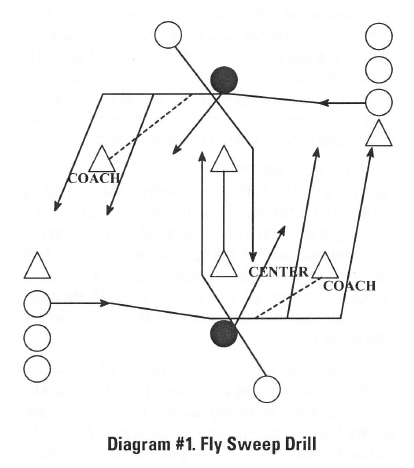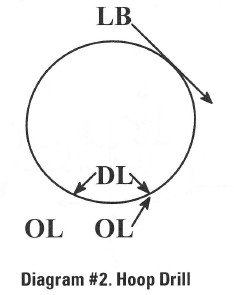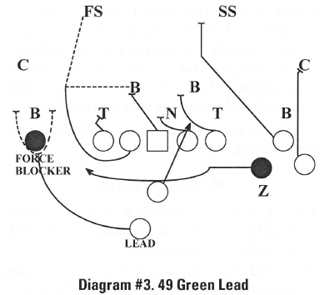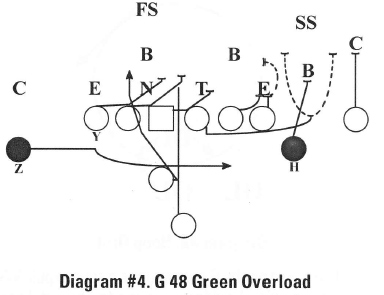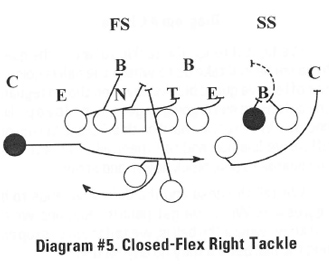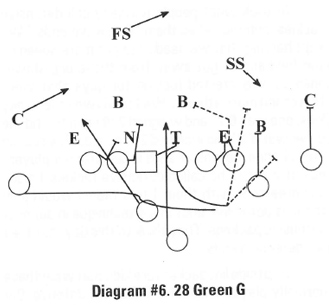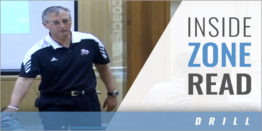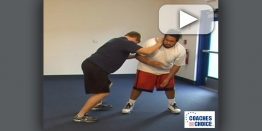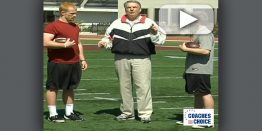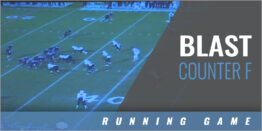| No Huddle Spread Offense: Fly Sweep
WHAT IS THE SZF?
The system is the shotgun zone fly series. The SZF focuses on the run as a power running game. This offense uses the quarterback as a primary runner, which forces the defense to cover the field like a spread team. At the same time, the offense has the ability to run the ball inside the tackles as well as on the perimeter. It is versatile in its application. We run the inside zone, quarterback zone, fly sweep, power, trap, and throw the ball. We throw, and we run. The entire idea behind this offense is it forces the defense to play sideline to sideline while we play goal line to goal line. We want to give the impression that we are a finesse football team and kick butt. We want to go at the defense. The reality of this offense is to get defenders out of the box. I do not want the linebackers coming downhill. Penetration is the thing that stops the running game. We want to spread the field and get defenders out of the box, but we are going to kick some butt. POINTS OF EMPHASIS
If I can keep the defense in their areas, I can usually find one area of the defense we can dominate. My goal is to keep your defense playing option-sound football in a contained area. I do not want a linebacker making plays hash mark to hash mark. If I can do that, we can find one area of field, and we can take an advantage. SZF SWEEP
If we can get the defense to show us in pre- snap what they are doing in coverage, it makes it easier for us. That is why we use so much motion. We use fly and pop motion. When we use the fly motion, people on the defense start to move, which give us tips and clues of what they are going to do. I want to talk about the sweep play. We run the sweep play 8 to 10 times a game. We run the sweep motion considerably more than the sweep. We use motion from our wide receiver or slot. We use some kind of motion on 80 percent of the plays we call. The fly motion comes from the wide receiver, and the pop or short motion comes from the slot players. The defense can stop the sweep. The question is what they give up to stop the sweep. We do not run the sweep but 8 to 10 times a game, but the defense has to spend a lot of practice time preparing for it. When we run the fly sweep, the first key element of the play is the mesh between the quarterback and sweeper. The heels of the quarterback are at four-and-a-half yards from the line of scrimmage with the weight on the inside of his feet. We spend many hours working on the snap and catching the snap. We want his knees slightly bent with the hands ready to receive the ball. We want the hands covering his numbers. His number- one priority is to get the snap. The half back aligns at six-and-a-half yards to the right or left of the quarterback in the shotgun. His depth is approximately two steps behind the quarterback. That depth can change with the timing of the play. If he is a faster running back, his depth could be seven-and-a-half yards. He aligns behind the guard and opposite the Z-receiver, which we call the Zebra. From that position, he can run the frontside and backside zone or the frontside power. The spacing between the Zebra, halfback, and the guard pull is two steps. Two steps are the timing element we use on this play. The formation determines split of the Zebra. If it is a normal formation, his split is around the numbers. When the Zebra starts in motion to the quarterback, he is running fast, but in a controlled manner. He uses a slide step (gets depth) at the outside leg of the tackle to move toward the quarterback's playside hip. That puts him on the sweep track. He rotates his shoulders slightly toward the quarterback. That puts his belly button to the ball and his back numbers to the linebackers. This is a tremendously important part of this play. This hides the ball and causes hesitation by the linebackers. This means the sweeper is responsible for hiding the ball. As he takes the handoff, he immediately locates the block on the force defender and attacks according to his read. If he is executing a fake, he does exactly the same thing, except he keeps his hands in a fist position and does not clamp down on the ball. If he is supposed to get the ball and it is not on the track when he gets there, do not slow down! He is now the lead blocker for the quarterback, who runs the ball on the track. The quarterback wants to snap the ball so that it arrives in his hands when the sweeper is two steps away. The landmark for the quarterback is the outside leg of the backside offensive tackle. He places the ball on the sweep track and hands the ball to the Zebra. He extends the ball forward into the path of the Zebra. That is the sweep track. The Zebra takes the ball from the quarterback. After he hands the ball off, he rotates on the leg that is on the halfback's aligned side, and fakes a handoff to the halfback. If the halfback is on a blocking track, the quarterback fakes an inside run after the exchange. If the quarterback does not feel comfortable about the exchange, due to a bad snap, he does not attempt to hand the ball off. He must secure the ball and then become the runner on the called track. If the quarterback is executing a handoff to the halfback, he brings the ball to his belt buckle, pivots/rotates on the leg toward the halfback, and places the ball on the inside run track. After the halfback takes the ball, the quarterback continues a run fake to the opposite side. He only rides a sweep fake with the ball when the halfback is on a blocking track or not aligned in the backfield. If the quarterback carries the ball, he executes the proper fake and attacks the called run lane. When we run this play, we are not looking to get to the sidelines. If you do not have the speed to get to the sidelines, you simply run out-of-bounds with a five-yard loss. We cut the ball back, depending on the block on the force player. We practice that daily in our sweep drill. If you want this play to be effective, you must do something to slow down the linebackers and make them hesitate. You do that with ball handling and faking. You must pay attention to details and demand they do it correctly. When we run the fly sweep drill, we run two groups at the same time (Diagram #1). We align two centers, facing one another 10 to 15 yards apart. The wide receivers align on the cones that mark their split to the outside of the centers. The quarterbacks align in their position with a halfback behind them. The sweeper comes in motion to the quarterback. The quarterback give the ball to the sweep, fakes to the halfback, and carries out his fake on the opposite side of the running back for one step past the line of scrimmage.
There are two coaches involved in the drill. They stand where the tight end's block would be and watch the mesh. He gives the sweeper a hook, a kick-out, or a head-up drive block read. The sweeper reacts to the block by cutting up (kick-out), running outside (hook), or dipping inside and accelerating outside (head-up block). The sweeper keeps the ball and runs for 10 yards off his read. He gives the ball to the other quarterback and returns to the sweep line on that side. We do this drill every day for five minutes. We try to get 25 reps during that time. When we expand the drill, we take the coach out of the drill and replace him with a tight end or H-back, who actually performs the block for the key read. We can time and run all three plays in this drill. We can run the sweep, the zone to the running back, and the quarterback zone play. We can block the sweep with three different methods. If we run the base sweep, we align and block the force from an alignment standpoint with no pull. We can run the G sweep and pull the playside guard. When we pull the frontside guard, the running back fills for the guard. We can run the lead sweep, where we lead with a back and a pulling guard. SZF: FLY SWEEP
We can run the play with the Zebra, H-back, and the quarterback. If we run 49, that is the Zebra sweep. If we run 29, that is the H-back sweep, or 19 is the quarterback play. If we run the play to the slot, we use pop motion instead of fly motion. The offensive line uses a scoop technique. It is the same type of blocking used on an outside zone play. We talk to our offensive lineman in terms of covered or uncovered. If the defense covers the offensive lineman, his job is to get his inside hand on the upfield shoulder of the defender. He wants to work his butt to get into a square position and turn the defender. The depth of the offensive lineman's step depends on the width of the defender. If the defender is head-up, the step is straight at the defender, working to get the inside hand on the upfield shoulder. We more than likely will be in a combination block of some sort on a head-up alignment. If the defender is inside, the blocking on the inside will take the defender, and the blocker punches him and works up to the second level. If the defender is outside the blocker, he has to lose ground to gain ground on the defender. He has to get depth off the line of scrimmage to get up to the outside of the defender. To drill this type of blocking, we use the hoop drill (Diagram #2). We align two offensive blockers on one side of the hoop. It could be a tight end and tackle or a tackle and guard. We put the defensive lineman inside the hoop and the linebacker on the top of the hoop. On the snap, the two offensive linemen block the defensive lineman and the linebacker. We work the punch and go. On that block, the defender slants inside. The outside blocker punches him and goes to the second level. We use all our combination techniques in this drill. The hoop teaches proper angle to get to the linebacker. This is a good drill for scoop blocking.
The guard on the G sweep uses a square pull. We never want his shoulders or eyes to the sidelines. He pulls, keeps his shoulders square, and his eyes go to the force block immediately. Everything we do on the perimeter depends on what happens with the force block. When we run this play, we do not talk about fronts. It does not matter whether it is a 4-3 or a 3-4. We talk in terms of covered or uncovered, the edge, and blocking the force. The offensive blocker on end the line of scrimmage blocks the force. FORCE BLOCKING
We call our sweep play "green." We can run it with a G, lead, or base scheme. FORMATION RULES
When we align in a formation, we must have a minimum of three perimeter blockers on the play. We want a wide receiver, tight end, and pulling guard on the perimeter. We could have a wing, halfback, and pulling guard. We want to get a hat on a hat and turn the ball up if necessary. When we align in our formation, we never want to take a split that allows the defender to jump inside and blow up the play. That is particularly true for the force defender. We take the defender as wide in our splits as he will go. However, we never want to get into a position where if the defender jumps inside, we cannot block him. We want to stress the defense by using unbalanced sets and overloads. We want to use quick motion formations and "nasty" splits on the force defenders. If the tight end takes a three split, it puts the defender covering him in a dilemma. The first play I want to show you comes from a tight trips formation. The play is a 49 green lead (Diagram #3). The force blocker is the tight end. He takes a nasty split on the outside linebacker. On this play, the playside guard is uncovered and pulls around the reach block of the tackle. The center scoops through the playside A gap and angles for the playside linebacker. If the linebacker blitzes that gap, the center blocks him.
The backside guard scoops for the shade noseguard. The backside tackle scoops through the B gap, trying to get to the second level. The play is a lead play. The running back becomes the lead blocker on this play. The quarterback has no fake with the running back. The quarterback can get a long ride with the Zebra since there is not a fake to the running back. After he rides the Zebra, he fakes the quarterback zone play to the backside. The pulling guard uses a square pull and sees the playside linebacker. If the playside linebacker blitzes into the B gap, the guard attacks him at that point. He is square and in position to make that block. However, his primary path comes from the block on the force. If the tight end washes the force inside, he goes around the outside and looks back inside. If there is no linebacker, he goes up to the safety running in the alley. The running back is the lead blocker on the play. He reads the force blocker and goes inside or outside his block, depending on his read. If the force blocker reaches the defender, he takes his block to the outside and blocks the corner. If the defender is working outside, the force blocker drives him outside, and the running back turns inside and blocks the first defender. The Zebra runs the ball and reads the same thing the lead blocker reads. If the blocker and force defender lock up in a stalemate, the Zebra dips inside and back to the outside. This set is an unbalanced formation with the tight end in a closed position to the right tackle (Diagram #4). The wingback in this set is the H-back set outside the tight end. The wide receiver and Zebra are off the line of scrimmage. The backside guard and tackle scoop through the backside A and B gaps and up to the second level. The center has to work hard and reach the 3-technique defender to the overload side. The best chance he has is to try to cut him.
The tackle and tight end run a combination block on the 6-technique defender. This is a zone blocking combination block, working for the 6 technique and the inside linebacker. The H-back has the force block on the outside linebacker. He tries to reach-block him, but blocks him any way he can. If the defender goes inside, he seals him inside. If the defender runs outside, he drive-blocks him and kicks him out. If it is a stalemate situation, the Pack wants to clip to the inside and take the play to the outside. The pulling guard uses the square pull and gets his eyes on the force blacker. He reads the direction of the block. If the H-back drives the force outside, the guard turns inside and up on the safety. He looks inside before he goes up to the safety and blocks the first defender who could make the play. The wide receiver stalk-blocks the corner. The quarterback hands to the Zebra. He rotates and fakes to the running back on the inside zone play. The running back has to fill on anything coming into the A gap. The quarterback fakes the quarterback zone or the bootleg off the fake. If, for some reason, the force blocker splits too wide and the force defender penetrates to his inside, the guard kicks him out, and we turn the ball inside immediately. We use another overload formation called a closed-flex right tackle (Diagram #5). We run the G 49 green. The tight end uses a nasty split from the right tackle, and the H-back sits in the tight slot alignment outside the right tackle. The backside guard and tackle scoop through the A and B gaps and up to the second level. The defense uncovers the center, and he blocks the 3-technique defender. He tries to cut him down or entangle his feet so he cannot pursue down the line.
The right tackle reaches the 5-technique defender on his outside shoulder. The tight end and wide receiver use a combination block on the outside linebacker with the wide receiver working off the block for the inside linebacker. We read this combination block as the force block. With a combination block, we should block the defender to the inside. However, the inside pulls have to read the block on the force. The H-back has no defender aligned over him and pulls to the outside around the combination block of the tight end and wide receiver. The pulling guard square-pulls and reads the combination block. He goes inside or outside the block. The quarterback gives the ball to the Zebra, fakes the running back, and runs a bootleg fake to the backside. This play is a 28 green G (Diagram #6). We run this to the H-back using pop motion. That is the short motion coming from the slot. The blocking is the same from the offensive line. If the defense is a 34 front, the tackle may have trouble with his reach block on a 5-technique defensive end, and he can call on the tight end to give him some help. The tight end reduces his split and helps the tackle. He punches the defender onto the block of the offensive tackle and gets off to the second level.
We can run the play from under the center. The quarterback wants to snap the ball at the same place and present the ball in the same fashion. The quarterback reverses to the motion and gets off the line of scrimmage. The running back runs the same fake, and the quarterback fakes the bootleg. The timing is the same from the quarterback and Zebra. The line blocking is the same, and the reads on the force block are the same. We run 5 to 10 percent of our snaps from under the center. I appreciate you being here. |
|
|




